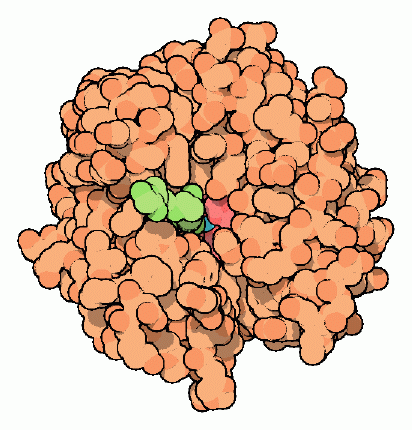|
Inhaltsübersicht | Nanomaschinen | Moleküle | Programme | Kurse | Fun | Links |
||
| > |
Carbonic Anhydrase

Carbonic Anhydrase in Health and Disease
Since this enzyme produces and uses protons and bicarbonate ions, carbonic anhydrase plays a key role in the regulation of pH and fluid balance in different parts of our body. In our stomach lining it plays a role in secreting acid, while the same enzyme helps to make pancreatic juices alkaline and our saliva neutral. The transport of the protons and bicarbonate ions produced in our kidney and eyes influence the water content of the cells at these locations. Thus carbonic anhydrase isozymes perform different functions at their specific locations, and their absence or malfunction can lead to diseased states, ranging from the loss of acid production in the stomach to kidney failure.When there is a build up of fluid that maintains the shape of our eyes, the fluid often presses on the optic nerve in the eye and may damage it. This condition is called glaucoma. In recent years, inhibitors of carbonic anhydrase are being used to treat glaucoma. Blocking this enzyme shifts the fluid balance in the eyes of the patient to reduce fluid build up thereby relieving pressure. The structure of PDB entry 1cnw shows how one such inhibitor (a sulfonamide), colored green in the figure, is bound to human carbonic anhydrase (isozyme II). Note that this inhibitor binds near the active site and disrupts the interactions of the water bound to the zinc ion, blocking the enzyme action. Unfortunately, prolonged use of this drug can affect the same enzyme present in other tissues and lead to side effects like kidney and liver damage.
Next: Exploring the Structure
Previous: Carbonic Anhydrase
Last changed by: A.Honegger,